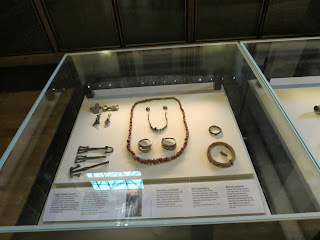Our group left London in two buses, arriving in the university town of Cambridge by mid morning. We had a short worship service at the Round Church with Dr. Steven Nichols preaching from Romans 3 on justification by faith and the Reformation. Quick tours of parts of the university, including the King's College Chapel, followed by a fish-and-chips lunch at the Eagle Pub (formerly the Eagle and Child, a favorite of C. S. Lewis during his time there), and then another tour of the old town and several of the colleges by a local Christian guide who specializes in the Reformation history of the town. Then it was back on the buses to go to York.
King's College Chapel interior (the nave):
The whole chapel is full of this stained glass:
This plaque denotes where the White Horse Inn used to stand; the building is long gone and the site taken over by one of the university colleges:
The window to the right overlooking the apple tree locates the rooms of Sir Isaac Newton at Trinity College:
Sunday, October 6, 2013
Thursday, October 3, 2013
Saturday, 17 August: Third Day in London
Cathedrals and castles--we visited St. Paul's Cathedral and Westminster Abbey in the morning, then Windsor Castle in the afternoon. All were relatively quick tours with no free time built in for personal exploration; for example, I've always wanted to climb St. Paul's dome and didn't get to do that this trip. Also, at every site we were warned against taking interior pictures. This seems to be the direction things are heading in Europe, as we ran up against the same prohibition when we visited the royal palace in Madrid last year. However, I have learned how to be surreptitious with a digital camera. The results may not be framed correctly, and sometimes what results is a bit blurry, but I manage to capture some sense of what things look like. So, some of the following are contraband:
The dome interior. That's paint up there.
This is the famous Christopher Wren epitaph: "Reader, if you seek his monument, look around you."
Westminster Abbey facade.
A bit hard to see, but this is the Coronation Chair. There is a slot under the seat for the Stone of Scone, but the Stone is in Edinburgh Castle. The portrait of Richard II is famous.
The Henry VII Chapel. Look at the fan vaulting in the ceiling.
Windsor Castle grounds. It's a big place.
What these guys have to put up with from tourists...
The dome interior. That's paint up there.
This is the famous Christopher Wren epitaph: "Reader, if you seek his monument, look around you."
Westminster Abbey facade.
A bit hard to see, but this is the Coronation Chair. There is a slot under the seat for the Stone of Scone, but the Stone is in Edinburgh Castle. The portrait of Richard II is famous.
The Henry VII Chapel. Look at the fan vaulting in the ceiling.
Windsor Castle grounds. It's a big place.
What these guys have to put up with from tourists...
Wednesday, October 2, 2013
Friday, 16 August: Second Day in London
In which we were treated to a private tour of some of the Tower of London, particularly the British Crown Jewels exhibit (sorry, no pictures of those--for security reasons, the guards permit no photography--but trust me, they're impressive); a visit to the Palace of Westminster and the Houses of Parliament with a tour of the House of Lords and House of Commons (again, no photos of the interior except for Westminster Hall, the oldest existing part of the palace). After a get-your-own lunch in Covent Garden, we visited the Wesley Chapel and House, located across the street from Bunhill Fields Cemetery, a Nonconformist (i.e., non-Anglican) burial site that has the tombs of John Bunyan, Daniel Defoe, John Owen, William Blake, and Susanna Wesley, among other notables. Sadly, due to a technical glitch I could not take photographs in the cemetery. The day ended with a dinner cruise on the Thames; I have representative shots of views of the city from the river (Greenwich; Tower Bridge; the Shard; the dome of St. Paul's Cathedral). The lovely lady contemplating her place setting is my wife, Shirley.
Special Edition: Sutton Hoo Artifacts
By popular demand...
Just as an introduction, the Sutton Hoo ship burial find occurred in the 1950s (I think), purportedly the grave of an early seventh-century Anglo-Saxon king; some scholars believe he was Raedwald of the East Angles, who had the status of bretwalda (high king, if the office ever really existed) toward the end of his reign. From an archeological perspective, the find was a veritable treasure-trove. At the time of our visit to the British Museum, the permanent exhibit of Anglo-Saxon artifacts was undergoing renovation, but many of the more important pieces were still on display. The following is a small sample of the collection.
Just as an introduction, the Sutton Hoo ship burial find occurred in the 1950s (I think), purportedly the grave of an early seventh-century Anglo-Saxon king; some scholars believe he was Raedwald of the East Angles, who had the status of bretwalda (high king, if the office ever really existed) toward the end of his reign. From an archeological perspective, the find was a veritable treasure-trove. At the time of our visit to the British Museum, the permanent exhibit of Anglo-Saxon artifacts was undergoing renovation, but many of the more important pieces were still on display. The following is a small sample of the collection.
Subscribe to:
Posts (Atom)

























































